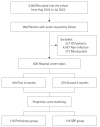Impact of the National Early Warning Score-based sepsis response system on hospital-onset sepsis in a tertiary hospital in South Korea
- PMID: 40405514
- PMCID: PMC12151737
- DOI: 10.4266/acc.000625
Impact of the National Early Warning Score-based sepsis response system on hospital-onset sepsis in a tertiary hospital in South Korea
Abstract
Background: The effectiveness of electronic medical record-based alert systems, response protocols for sepsis diagnosis, and treatment in hospitalized patients remains unclear. This study aimed to determine whether the introduction of an electronic medical record-based sepsis response protocol (SRP) along with a 24/7 operating rapid response system affects the prognosis for patients with hospital-onset sepsis.
Methods: In August 2022, a SRP based on the National Early Warning Score was implemented in the electronic medical record system at Asan Medical Center. We retrospectively analyzed patients screened by the detection system for 1 year after the SRP implementation. Patients of the first 6 months (preliminary group) and those of the second 6 months (SRP group) were matched 1:1 based on propensity scores. The primary outcome was 30-day mortality.
Results: Of the 608 hospitalized patients screened by the system, 176 were assigned to each group after 1:1 propensity score matching. Patients in the SRP group were significantly more likely to receive blood cultures (58.5%) compared with the preliminary group (45.5%) (P=0.019). The SRP group showed a lower 30-day mortality risk (hazard ratio, 0.56; 95% CI, 0.36-0.86; P=0.017) compared to the preliminary group. A restricted cubic spline curve showed that SRP survival benefit began to manifest after the first 4 months (P=0.036).
Conclusions: Alongside an existing rapid response system, the National Early Warning Score-based SRP in the electronic medical record reduced mortality for hospital-onset sepsis within 1 year.
Keywords: early diagnosis; electronic health records; hospital rapid response team.
Conflict of interest statement
No potential conflict of interest relevant to this article was reported.
Figures






References
-
- Rhee C, Wang R, Zhang Z, Fram D, Kadri SS, Klompas M, et al. Epidemiology of hospital-onset versus community-onset sepsis in U.S. hospitals and association with mortality: a retrospective analysis using electronic clinical data. Crit Care Med. 2019;47:1169–76. doi: 10.1097/ccm.0000000000003817. - DOI - PMC - PubMed
-
- Rose N, Spoden M, Freytag A, Pletz M, Eckmanns T, Wedekind L, et al. Association between hospital onset of infection and outcomes in sepsis patients: a propensity score matched cohort study based on health claims data in Germany. Int J Med Microbiol. 2023;313:151593. doi: 10.1016/j.ijmm.2023.151593. - DOI - PubMed
LinkOut - more resources
Full Text Sources

